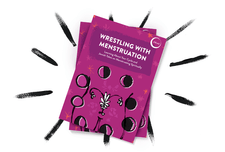At The Well with Sarah Waxman
Menstruation: A little over half of all bodies do it, have done it, or will one day be doing it, and yet we are encouraged to not be curious about this physical process that literally makes life possible. At The Well (ATW), a Jewish women's wellness nonprofit, is seeking to bridge that artificial (and patriarchally imposed) gap between women, their bodies, and spirituality.
After poring through ATW’s gorgeous Instagram page and reading their educational, eye-opening zine, Wrestling with Menstruation, I caught up with ATW founder Sarah Waxman, and asked her about her work to not only de-stigmatize menstruation, but imbue the conversation with joy, spirituality, and sisterhood.
How did At The Well get its name? What inspired that choice?
We were looking for images in Judaism that were uniquely feminine. The image of “the well” came up early and I immediately fell in love with it. It was a meeting space for many, a place of revelation for Rabbi Akiva and others, a place to receive sustenance, and news from the community. I also loved that it was a nod to Miriam, our wild dance machine spiritual leader (aka one of our #BiblicalBabes), who supported the Israelites during our wandering. Lastly, it's a cute play on Wellness, which is what we’re all about.
Why is it important that we talk about menstruation?
Half of all living creatures on this planet live in bodies that are made to cycle and bleed; this is an important, necessary experience responsible for bringing new life into the world.
The stigmatization and shame surrounding menstruation need to end, and the social acceptance of this conversation is long overdue. It is a great injustice to women that so little information about the health and science of the female body has been made available to us.
Why does menstruation, in a Jewish context, matter to you?
Jewish people are on a spectrum and continuum of practice and faith, but for menstruation there is a clear line in the sand. For Orthodox women, the practice of cycle tracking, Niddah and Taharat Misphacha are key rituals of Jewish faith. But for most Jewish women outside of the traditional spaces, this is a conversation we literally never have in any of our Jewish education. I don’t know of anything else this polarizing within the rituals, laws, and traditions of Judaism.
I see the beauty in looking at this challenging conversation from all sides. It’s time we brought it into the vocabulary of Jewish education. There are volumes of text written about how to be in relation to your body, partner, and spiritual self during menstruation. Why are we avoiding these conversations about women’s bodies in Judaism? They are both beautiful and painful… similar to the feeling of bleeding!
To bring divinity into the conversation, it is Jewish practice to track the menstrual cycle! Niddah (meaning “a menstruating woman”), are the Jewish laws governing the week of, and following, a woman’s menstruation. It’s essentially a practice of counting, honoring, and separation.
What do you hope Jewish women will gain from the work of ATW?
ATW envisions a world where women feel whole. Our mission is to unite the practices of wellness and holiness––of physical health and Jewish spirituality––in order to live full lives.
The majority of the work we do is in educating women about their bodies, bringing them together with other women, and linking these practices with their personal spirituality. Our theory, is that this type of work can contribute to lower rates of depression and anxiety in women. We hold onto the idea of Well Circles––Rosh Chodesh meetings on, or around, each new moon––because we know that there are real, positive, physiological changes that occur in the female brain when she spends time with other females.
We also know that being educated and living in awareness with what is happening hormonally in our bodies can give us a sense of power and choice. This awareness is what permits us to be less hard on ourselves for the feelings we are experiencing and to learn to make choices that best support our wholeness in each moment.

Wrestling with Menstruation, At The Well's new zine, tackles menstruation through a spiritual and scientific lens. (Image courtesy of At the Well)
How are ATW’s goals furthered by your new zine, Wrestling With Menstruation?
Wrestling With Menstruation is the perfect example of how we are unifying health and spirituality, of wellness and holiness. This intersection is ATW’s sweetspot. We are using sacred text, science, and humor in this zine to speak about our menstrual cycle through both a scientific and spiritual lens.
In a female's reproductive years, the hormones in her body change literally every day. Every day. I asked myself: How have I lived the vast majority of my menstruating days with no awareness of the constant state of change my body is in? How could I possibly know how to treat myself, talk to myself, and make healthy choices about my physical body and mental health without first tracking and learning about this cycle?
It’s a very powerful feeling and I wanted to share it, which is what led to the creation of Wrestling with Menstruation.
Every woman’s journey is different, but the moment I learned to track my cycle was the moment I finally understood what it means to be connected with, and inside of, my body. I began to understand the true meaning of inhabiting this beautiful, female, cyclical body of mine, and the affect it has on how I feel emotionally, physically, and spiritually. I finally had a way to contextualize the current of my body, to understand the ebbs and flow (pun intended).
This book was written for women in their 20s and 30s. I think it is certainly useable for any menstruating age, but I would encourage anybody working with teens to buy a copy to read themselves first.
In order for Wrestling With Menstruation to reach its full potential for impact, people must use it in intimate conversations, all over the world. It’s these conversations that will chip away at societal taboos. In order for that to happen we need you to come be a part of it. We need our sisters, Jewish and non-Jewish alike. All we did was write it down, but we need to educate and elevate each other in order to define and discover for ourselves what it means to be whole.
And that includes our grandfathers, our dads, our brothers, our lovers, and our friends who don’t have vaginas and will never bleed. They need to read and talk about this too.
In the zine, you tackle excerpts from the Niddah through the perspectives of four very spiritually different Jewish feminists—the “Four Menstruators.” Can you speak more about this section?
We intentionally designed Wrestling With Menstruation to feel like Talmud. It was important to us to create something that respected the beauty of the tradition we come from. We chose four menstruators as a nod to the four sons at Passover, and I think we do a pretty good job of covering all the diverse opinions on the topic.
It’s a bit absurd that these laws were created by all male scholars, who had no experience in a menstruating body, or have even seeing the process, right? Jewish women have always been literate, but we were never invited to participate in the written tradition. There’s no doubt Jewish women ruled in the storytelling and oral wisdom department, but sadly, a lot of those teachings were lost along with so many of our people over the course of centuries of persecution.
Now, we are missing so much information; we don’t even know what we don’t know! I truly believe that my namesake––Sarah––had so much more to say than what is documented in Genesis. ATW is bringing oral tradition back through our network of Well Circles, but Wrestling With Menstruation is a great example of how we are ensuring there will be a record and that we will not lose these stories. Text is an important part of our tradition and it’s about time women started owning the part of the conversation about our bodies.
Who are some of your Jewish feminist role models?
Queen Esther is my spirit prophetess. She is the reason I found the courage to jump into this work, and I call on her every day.
Esther’s uncle, Mordecai, came to her and told her she needed to step up and save the Jewish people. Like any normal Jewish leader she was resistant and hesitant at first. BUT, her uncle gently suggested, perhaps she was the right person at the right time with potential to make it happen. This struck a chord, so she prepared herself. She sought out others for support and leaned into her strengths, into her femininity and her sacred feminine powers. Then, without shame, without weakness, with a lot of bold courage, Esther saved the day (you can read more here).
I read that line of Megillah text after three years of dreaming about the potential of ATW. Finally one Purim, I realized I was the only person I was waiting for, that perhaps I was the right person at the right time, with the right skills to build what I was dreaming. And then I prepared myself, leaned way into my strengths, leaned in to my community, and continue to lean into my feminine power.







